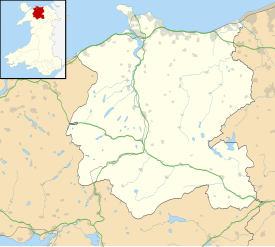Plas Mawr
| Plas Mawr | |
|---|---|

The gatehouse of Plas Mawr, showing its characteristic Renaissance crow-stepped gables, pedimented windows and heraldry
|
|
| Location | Conwy, Wales |
| Coordinates | 53°16′52″N 3°49′44″W / 53.2811°N 3.8288°WCoordinates: 53°16′52″N 3°49′44″W / 53.2811°N 3.8288°W |
| Built | 1576–85 |
| Built for | Robert Wynn |
| Restored | 1993–94 |
| Governing body | Cadw |
| Website | Plas Mawr |
Plas Mawr (English: Great Hall) is an Elizabethan townhouse in Conwy, North Wales, dating from the 16th century. The property was built by Robert Wynn, a member of the local gentry, following his marriage to his first wife, Dorothy Griffith. Plas Mawr occupied a plot of land off Conwy's High Street and was constructed in three phases between 1576 and 1585 at a total cost of around £800. Wynn was known for his hospitality, and the household was supported by Wynn's local dairy herds, orchards and gardens. On his death he laid out complex instructions for dividing his estate; the resulting law-case took years to resolve, effectively preventing the redevelopment of the house and preserving it in its original condition.
After 1683 Plas Mawr passed into the hands of the Mostyn family and ceased to be used as a family home. It was rented out for various purposes during the 18th and 19th centuries, including for use as a school, cheap lodgings and finally as the headquarters of the Royal Cambrian Academy of Art. In the 20th century the house became increasingly well known for its preserved Elizabethan architecture, but the costs of maintenance grew considerably and its condition deteriorated. The Welsh heritage agency Cadw took over the management of the property in 1993 and carried out an extensive, 42-month-long restoration project at a total cost of £3.3 million. With many of its rooms redecorated to resemble their condition in 1665, and replanted Renaissance gardens, it is now run as a tourist attraction.
Architecturally, Plas Mawr is almost unchanged from the 16th century, and the historian Rick Turner considers the house to be "the finest surviving town house of the Elizabethan era". Plas Mawr shows a blend of continental Renaissance and local North Wales influences, with an innovative floor-plan and architectural detailing. The house still retains much of its original plasterwork, which incorporates symbols, badges and heraldry, which the historian Peter Smith has described as "the most perfect and the most complete memorial to Elizabethan Wales." The architecture of the house influenced other contemporary projects in North Wales, and was later copied during the 19th and 20th centuries in buildings around the town of Conwy, including the local police station and nearby hotel.
Plas Mawr was built in the town of Conwy between 1576 and 1585 by Robert Wynn. Robert came from a prosperous local family and entered the service of first Sir Walter Stonor and then Sir Philip Hoby, both administrators and senior officials to King Henry VIII. Robert fought and was injured at the Siege of Boulogne in 1544, took part in military campaigns in Scotland and traveled extensively across Europe. He invested in land across North Wales and married his first wife, Dorothy Griffith, a member of the local gentry, in 1570. Once married, Robert needed a suitable house and chose to settle in Conwy, a prosperous town that was known in the 16th century for its genteel society.
...
Wikipedia

